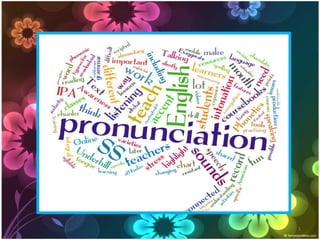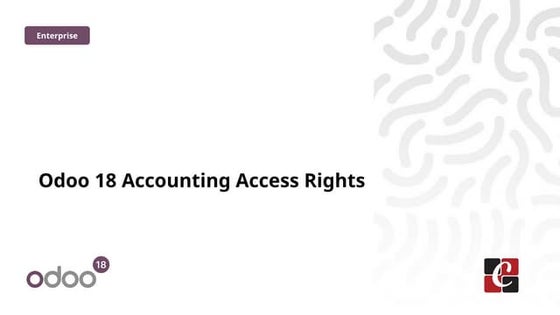Pronunciation: To teach or not to teach
Download as PPTX, PDF20 likes7,577 views
This presentation will provide you with the necessary tools and give you ideas on how to engage students in pronunciation practice. In addition, students will get aware of the importance of pronunciation
1 of 37
Downloaded 717 times





































Recommended
Improving Pronunciation



Improving PronunciationEducation Front
Ã˝
This document discusses various linguistic concepts related to improving pronunciation in English. It covers phonetics and phonology, the International Phonetic Alphabet, phonemes, the sounds of English, syllables, stress, connected speech features like assimilation and elision, and provides examples to illustrate these concepts. The goal is to help learners understand and accurately produce the sounds of English for effective oral communication.English Pronunciation



English PronunciationJoy Celestial
Ã˝
This document provides an introduction to English pronunciation, discussing the 3 levels of pronunciation proficiency and sources of accent for non-native English speakers. It explains key linguistic concepts like phonetic transcription, places and manners of articulation for consonant sounds, and voicing. The document emphasizes that proper instruction and practice are needed to improve pronunciation skills beyond just awareness or knowledge. Mastering the articulation of English sounds requires training muscle groups through regular practice.Teaching pronunciation



Teaching pronunciationIvan Aguilar
Ã˝
The document outlines a framework for teaching pronunciation. It begins by describing common pronunciation problems students may have with words, stress, and intonation. It then discusses techniques for teaching pronunciation, including drilling, minimal pairs, chants, role plays, and using technology. Finally, it presents a 5-stage framework for teaching pronunciation: 1) describing the phonetic feature, 2) listening discrimination exercises, 3) controlled practice, 4) guided practice combining form and meaning, and 5) communicative practice integrating pronunciation into speaking.Teacher Training Pronunciation



Teacher Training PronunciationStephen Cloak
Ã˝
This document provides guidance for teaching pronunciation to English language learners. It discusses the parts of the body used to make sounds, and recommends teaching phonetics gradually by introducing it when errors are noticed or in textbook lessons. Teaching techniques include exaggerating mouth movements, drilling sounds, and relating them to images. The document emphasizes making phonetics fun and explains concepts like vowel/consonant sounds, voiced/unvoiced sounds, stress patterns, and syllables. It also addresses when to pronounce 'ed' as /t/, /d/ or /Id/ depending on the preceding sound. Real examples are provided to demonstrate pronunciation rules.Pronunciation



Pronunciationhangha
Ã˝
The document discusses the importance of pronunciation in language learning. It argues that pronunciation should be emphasized early in the learning process, as pronunciation habits are formed early and errors can become fossilized. The document outlines several key phonological differences between English and Portuguese related to phonetic signaling, phonemes (vowels and consonants), phonological rules, rhythm, vowel reduction, and word stress. It also discusses challenges related to spelling interference for Portuguese learners of English due to inconsistencies between English spelling and pronunciation.The Sounds of English



The Sounds of Englishm nagaRAJU
Ã˝
- The document discusses some of the inconsistencies between English letters and sounds, such as one letter representing multiple sounds and one sound being represented by multiple letter combinations.
- It provides examples of words that demonstrate different letter-sound relationships like silent letters, vowel and consonant sounds, and diphthongs.
- The last sections show charts of words organized by common letter patterns to illustrate the various ways sounds can be spelled in English.Basic English phonetics



Basic English phoneticsJosé Antonio Alcalde López
Ã˝
This document discusses basic English phonetics. It begins by explaining why the study of phonetics is important, as English pronunciation and spelling differ and knowledge of phonetics allows one to pronounce new words. It then defines phonetics as the study of human speech and discusses the International Phonetic Alphabet used to represent sounds. The document goes on to explain English vowels and diphthongs, as well as consonants. It notes differences between pronunciations of British and American English. The document also discusses stress, connected speech, and some main difficulties for Spanish speakers in pronouncing English sounds.Towards better pronunciation



Towards better pronunciationeltguide
Ã˝
The document provides an overview of phonetics and pronunciation teaching. It discusses the objectives of improving pronunciation, defines phonetics and phonology, and explains the difference between them. It also describes features of good pronunciation, the articulation process, segmental and suprasegmental features, and rules for teaching pronunciation including using minimal pairs and sets. The goal is for participants to understand pronunciation at an articulatory level and effectively teach English sounds and prosody.Phonics.ppt



Phonics.pptNabaeghaNajam1
Ã˝
Phonics is a method of teaching reading skills by learning the sounds associated with letters and letter combinations. It involves:
1. Teaching children to break words into individual sounds or phonemes and blend the sounds to read whole words.
2. Daily 20 minute phonics lessons in school where phonics strategies are used to read and write.
3. Assessing children's phonics knowledge through a national screening check in Year 1 to identify what needs to be learned in Year 2.
The screening check involves reading real words and nonsense words to test knowledge of sounds. Being able to segment and blend sounds is important for decoding unfamiliar words.Phonics power point



Phonics power pointYusuf Ozdemir
Ã˝
Phonics involves teaching students the relationships between letters and sounds. It builds upon phonological awareness by connecting sounds to letters. Phonics can be difficult for students to learn due to inconsistencies in English spelling rules. Teachers can help students learn phonics through activities like name puzzles, interactive writing, teaching consonant blends and digraphs. As students progress, teachers focus more on phonics instruction and less on phonological awareness. Phonics is assessed through measures like TPRI, anecdotal records, student work samples, and phonics worksheets. The overall goal is for students to gain reading proficiency through regular phonics practice.International Phonetic Alphabet 



International Phonetic Alphabet Bernadeth Ouano
Ã˝
The three body parts used for language and speech are the brain for memory and coordination, the vocal cords to make sounds, and the mouth to monitor pronunciation. The document then discusses the smallest units of speech - phonemes and syllables - and how words are formed from combinations of syllables. It explains vowels and consonants, diphthongs, and the International Phonetic Alphabet used in dictionaries to indicate pronunciation. Various consonant types - plosives, nasals, fricatives, sibilants, approximants, affricates, and laterals - are defined in terms of their manner of articulation.Zia.phoneme.ppt



Zia.phoneme.pptZia, Cadet College Kohat, Pakistan
Ã˝
The document discusses phonemes, which are the smallest units of sound in a language that distinguish one word from another. It provides details on phonetics, the scientific study of speech sounds, and phonology, the study of a language's phonemes. The International Phonetic Alphabet (IPA) contains symbols that represent the sounds of English. There are consonants, which involve closure or obstruction of airflow, and vowels, which use an open vocal tract. The document examines English consonant and vowel phonemes in detail.Vowels



Vowelssunokpera
Ã˝
Here are 10 common spellings each for the long vowel /i:/ and short vowel /i/ in English:
/i:/
ee, as in tree
ea, as in leaf
ie, as in chief
e, as in machine
e_e, as in these
ey, as in they
ei, as in seize
eigh, as in eight
i, as in police
y, as in rhyme
/i/
i, as in bit
y, as in happy
ie, as in friend
igh, as in high
e, as in women
a, as in various
o, as in women
u, as in business
ePhonics and Teaching Activities



Phonics and Teaching ActivitiesCaroline Liu
Ã˝
This document discusses phonics instruction and activities for teaching phonics. It begins by explaining what phonics is and why it is important to teach. It then outlines the scope and sequence of phonics, including single consonants, short vowels, blends, digraphs, long vowels, and more. Different approaches to phonics instruction are described such as direct, integrated, and embedded. The rest of the document provides examples of hands-on games and activities that can be used to teach various phonics concepts in a fun way, including alphabet sets, sound discrimination games, word games, and online songs and games.Intonation and its types rules 



Intonation and its types rules Garret Raja
Ã˝
This document discusses principles of intonation in language. It explains that intonation is about how speech rises and falls, rather than the words themselves. There are two basic intonation patterns: falling and rising. Falling intonation is used for statements, commands, wh-questions and exclamations. Rising intonation invites further speech and is used for yes/no questions and question tags that are real questions. Sometimes a combination of rising and falling, called rise-fall or fall-rise, is used for things like choices, lists, unfinished thoughts and conditional sentences.English phonetics



English phoneticsJaved Khatri
Ã˝
The given Presentation was delivered by Mr. Digant Chauhan at a plenary session on English Phonetics, BITS edu Campus. phonemes 



phonemes RajpootBhatti5
Ã˝
Phonemes are the smallest units of sound that distinguish one word from another in a language. There are 44 phonemes in English represented by letters alone or letter combinations. Phonemes can be segmented from words by breaking words into their individual sound units. The English language has a complex phonetic code where one phoneme can be represented by 1 to 4 letters. Minimal pairs are word pairs that differ by one phoneme, like "fan" and "van", helping learners distinguish similar sounds.Introduction to phonics lesson 1



Introduction to phonics lesson 1Lindsey Cottle
Ã˝
This document provides an overview of a 14-lesson phonics class for parents. It introduces phonics, explaining that phonics is the relationship between letters and sounds. It discusses why phonics is important for learning to read and spell. The document also outlines the stages of learning phonics from basic sounds to more advanced combinations. Finally, it proposes methods for teaching phonics including songs, games, and practice.Pronunciation



PronunciationLabeeda Farid
Ã˝
This is my 1st semester assignment on "Pronunciation" topic. This assignment will help the reader to understand how to pronounce English phonemes correctly. International Phonetic Alphabet is the tool for English students to practice their pronunciation. Speak English



Speak EnglishSeyid Kadher
Ã˝
This document provides tips for improving English pronunciation and speaking abilities. It recommends observing the mouth movements of fluent English speakers, slowing down speech, focusing on removing one's native language influence, listening to English media, finding English speaking friends both online and in person, practicing singing English songs, learning the phonetic alphabet, focusing on individual problem sounds, and ensuring clear enunciation even if retaining an accent. The key is being understood while gradually increasing comfort through regular practice speaking English.Learning English as a Second Language



Learning English as a Second LanguageAurora Computer Studies
Ã˝
This document discusses the importance of learning English as a second language. It outlines reasons such as English being the global language of business, education, and communication. It emphasizes that effective communication skills are important for academic and career success. The document provides a strategy for learning English that involves understanding grammar rules, vocabulary words, and usage patterns while also practicing through reading, writing, speaking and listening in English. Regular practice is encouraged to develop fluency and excellence in the language over time.English Pronunciation



English PronunciationPhi Pham
Ã˝
If you need to pronounce correctly, do not hesitate to download and use it !! i am sure you will get better way to fix your pronnunciation !Speech organ and manner of articulation



Speech organ and manner of articulationYanti95
Ã˝
This document discusses speech organs and the three dimensions of articulation. It defines speech organs as the parts of the body involved in sound production, including passive organs like the lips and alveolar ridge, as well as active organs like the tongue. It then explains the three dimensions of articulation - voicing, place of articulation, and manner of articulation. Voicing refers to whether vocal cords vibrate during sound production. Place of articulation is where in the mouth a sound is made. Manner of articulation describes how the air stream is modified, such as stops, fricatives, nasals, etc.teaching pronunciation activity



teaching pronunciation activityjinjoomoon718
Ã˝
This document provides guidance on teaching pronunciation to students. It begins with an introduction that explains common pronunciation errors students make and the importance of teaching pronunciation. It then outlines segmental and suprasegmental activities teachers can use. Segmental activities focus on individual sounds and include rhyming, minimal pairs, and hidden games. Suprasegmental activities teach features such as word stress, intonation, and misheard song lyrics through activities like stand up/sit down, adding arrows to songs, and guessing correct lyrics. The overall summary is that the document offers pronunciation teaching techniques including segmental and suprasegmental activities for teachers to use in the classroom.Minimal pairs



Minimal pairsAli Jathmi
Ã˝
The document discusses minimal pairs, which are pairs of words that differ by only one sound. Minimal pairs are useful for distinguishing between similar sounds. Some examples of minimal pairs provided are thin/thing, alive/arrive, sea/she, fan/van, fat/hat, free/three, sink/think, with/whizz, and page/pays. A minimal pair consists of two words or phrases that differ in only one phonological element, such as the onset, nucleus, or coda of a syllable.Ling101 phonological rules



Ling101 phonological rulesminhanviet
Ã˝
Phonological rules describe how phonemes are realized as allophones based on neighboring sounds. They are written as X->Y/W_Z, where X becomes Y between sounds W and Z. Assimilation rules make a sound more similar to a neighboring sound, either anticipatory or perseveratory. Dissimilation rules make a sound less similar to neighbors. Neutralization rules result in loss of phonemic distinction. Other rules involve fortition, lenition, epenthesis, deletion, and metathesis.Pronunciation problems of non native speakers of english



Pronunciation problems of non native speakers of englishEl Sameeha
Ã˝
This document discusses pronunciation problems faced by non-native English speakers and ways to overcome them. It defines non-native speakers as those whose first language is not English. It identifies some common pronunciation issues speakers of Arabic, Cantonese, French, Hindi, and Spanish may encounter. These include confusing similar sounds like /p/ and /b/ in Arabic or /θ/ and /d/ in Malaysian English. Factors causing problems are a lack of confidence, vocabulary, and focus on pronunciation in teaching. Ways to improve include practicing pronunciation, listening to English extensively, and using audio materials and qualified phonology teachers.Syllable and Word stress



Syllable and Word stressVasundhara Rawat
Ã˝
This document discusses syllables and syllable stress in words. It defines a syllable as the sound of a vowel created when pronouncing letters like A, E, I, O, U. The number of syllables in a word is equal to the number of vowel sounds. Words can be mono-syllabic, having one syllable, or poly-syllabic, having multiple syllables. All multi-syllable words have one syllable that is stressed, making it longer, higher in pitch, and louder. The rules for determining stressed syllables in words of different types are explained. Examples are provided to demonstrate applying word stress correctly.pt.pptx



pt.pptxQunhQunh46
Ã˝
This document provides guidance on teaching pronunciation in the English as a second language (ESL) classroom. It discusses defining pronunciation goals for students in a sensitive manner. Teaching pronunciation can improve comprehensibility, listening skills, and ability to communicate effectively in English. The document covers teaching pronunciation at both the segmental (individual sounds) and suprasegmental (stress, rhythm, intonation) levels. It provides examples of techniques for teaching sounds and prosodic features, including minimal pairs, tongue twisters, dictation, and exploring the impact of students' first language. The goal of teaching pronunciation is to help students improve their ability to understand others and be understood.5W1H of English Mastery



5W1H of English MasteryLanguagelab Group
Ã˝
Combing through language experts' memoirs, autobiographies, interviews and quotes from third-party websites, their views on English Mastery converge on this simple fact: Use it with feedback often or lose it. More Related Content
What's hot (20)
Phonics.ppt



Phonics.pptNabaeghaNajam1
Ã˝
Phonics is a method of teaching reading skills by learning the sounds associated with letters and letter combinations. It involves:
1. Teaching children to break words into individual sounds or phonemes and blend the sounds to read whole words.
2. Daily 20 minute phonics lessons in school where phonics strategies are used to read and write.
3. Assessing children's phonics knowledge through a national screening check in Year 1 to identify what needs to be learned in Year 2.
The screening check involves reading real words and nonsense words to test knowledge of sounds. Being able to segment and blend sounds is important for decoding unfamiliar words.Phonics power point



Phonics power pointYusuf Ozdemir
Ã˝
Phonics involves teaching students the relationships between letters and sounds. It builds upon phonological awareness by connecting sounds to letters. Phonics can be difficult for students to learn due to inconsistencies in English spelling rules. Teachers can help students learn phonics through activities like name puzzles, interactive writing, teaching consonant blends and digraphs. As students progress, teachers focus more on phonics instruction and less on phonological awareness. Phonics is assessed through measures like TPRI, anecdotal records, student work samples, and phonics worksheets. The overall goal is for students to gain reading proficiency through regular phonics practice.International Phonetic Alphabet 



International Phonetic Alphabet Bernadeth Ouano
Ã˝
The three body parts used for language and speech are the brain for memory and coordination, the vocal cords to make sounds, and the mouth to monitor pronunciation. The document then discusses the smallest units of speech - phonemes and syllables - and how words are formed from combinations of syllables. It explains vowels and consonants, diphthongs, and the International Phonetic Alphabet used in dictionaries to indicate pronunciation. Various consonant types - plosives, nasals, fricatives, sibilants, approximants, affricates, and laterals - are defined in terms of their manner of articulation.Zia.phoneme.ppt



Zia.phoneme.pptZia, Cadet College Kohat, Pakistan
Ã˝
The document discusses phonemes, which are the smallest units of sound in a language that distinguish one word from another. It provides details on phonetics, the scientific study of speech sounds, and phonology, the study of a language's phonemes. The International Phonetic Alphabet (IPA) contains symbols that represent the sounds of English. There are consonants, which involve closure or obstruction of airflow, and vowels, which use an open vocal tract. The document examines English consonant and vowel phonemes in detail.Vowels



Vowelssunokpera
Ã˝
Here are 10 common spellings each for the long vowel /i:/ and short vowel /i/ in English:
/i:/
ee, as in tree
ea, as in leaf
ie, as in chief
e, as in machine
e_e, as in these
ey, as in they
ei, as in seize
eigh, as in eight
i, as in police
y, as in rhyme
/i/
i, as in bit
y, as in happy
ie, as in friend
igh, as in high
e, as in women
a, as in various
o, as in women
u, as in business
ePhonics and Teaching Activities



Phonics and Teaching ActivitiesCaroline Liu
Ã˝
This document discusses phonics instruction and activities for teaching phonics. It begins by explaining what phonics is and why it is important to teach. It then outlines the scope and sequence of phonics, including single consonants, short vowels, blends, digraphs, long vowels, and more. Different approaches to phonics instruction are described such as direct, integrated, and embedded. The rest of the document provides examples of hands-on games and activities that can be used to teach various phonics concepts in a fun way, including alphabet sets, sound discrimination games, word games, and online songs and games.Intonation and its types rules 



Intonation and its types rules Garret Raja
Ã˝
This document discusses principles of intonation in language. It explains that intonation is about how speech rises and falls, rather than the words themselves. There are two basic intonation patterns: falling and rising. Falling intonation is used for statements, commands, wh-questions and exclamations. Rising intonation invites further speech and is used for yes/no questions and question tags that are real questions. Sometimes a combination of rising and falling, called rise-fall or fall-rise, is used for things like choices, lists, unfinished thoughts and conditional sentences.English phonetics



English phoneticsJaved Khatri
Ã˝
The given Presentation was delivered by Mr. Digant Chauhan at a plenary session on English Phonetics, BITS edu Campus. phonemes 



phonemes RajpootBhatti5
Ã˝
Phonemes are the smallest units of sound that distinguish one word from another in a language. There are 44 phonemes in English represented by letters alone or letter combinations. Phonemes can be segmented from words by breaking words into their individual sound units. The English language has a complex phonetic code where one phoneme can be represented by 1 to 4 letters. Minimal pairs are word pairs that differ by one phoneme, like "fan" and "van", helping learners distinguish similar sounds.Introduction to phonics lesson 1



Introduction to phonics lesson 1Lindsey Cottle
Ã˝
This document provides an overview of a 14-lesson phonics class for parents. It introduces phonics, explaining that phonics is the relationship between letters and sounds. It discusses why phonics is important for learning to read and spell. The document also outlines the stages of learning phonics from basic sounds to more advanced combinations. Finally, it proposes methods for teaching phonics including songs, games, and practice.Pronunciation



PronunciationLabeeda Farid
Ã˝
This is my 1st semester assignment on "Pronunciation" topic. This assignment will help the reader to understand how to pronounce English phonemes correctly. International Phonetic Alphabet is the tool for English students to practice their pronunciation. Speak English



Speak EnglishSeyid Kadher
Ã˝
This document provides tips for improving English pronunciation and speaking abilities. It recommends observing the mouth movements of fluent English speakers, slowing down speech, focusing on removing one's native language influence, listening to English media, finding English speaking friends both online and in person, practicing singing English songs, learning the phonetic alphabet, focusing on individual problem sounds, and ensuring clear enunciation even if retaining an accent. The key is being understood while gradually increasing comfort through regular practice speaking English.Learning English as a Second Language



Learning English as a Second LanguageAurora Computer Studies
Ã˝
This document discusses the importance of learning English as a second language. It outlines reasons such as English being the global language of business, education, and communication. It emphasizes that effective communication skills are important for academic and career success. The document provides a strategy for learning English that involves understanding grammar rules, vocabulary words, and usage patterns while also practicing through reading, writing, speaking and listening in English. Regular practice is encouraged to develop fluency and excellence in the language over time.English Pronunciation



English PronunciationPhi Pham
Ã˝
If you need to pronounce correctly, do not hesitate to download and use it !! i am sure you will get better way to fix your pronnunciation !Speech organ and manner of articulation



Speech organ and manner of articulationYanti95
Ã˝
This document discusses speech organs and the three dimensions of articulation. It defines speech organs as the parts of the body involved in sound production, including passive organs like the lips and alveolar ridge, as well as active organs like the tongue. It then explains the three dimensions of articulation - voicing, place of articulation, and manner of articulation. Voicing refers to whether vocal cords vibrate during sound production. Place of articulation is where in the mouth a sound is made. Manner of articulation describes how the air stream is modified, such as stops, fricatives, nasals, etc.teaching pronunciation activity



teaching pronunciation activityjinjoomoon718
Ã˝
This document provides guidance on teaching pronunciation to students. It begins with an introduction that explains common pronunciation errors students make and the importance of teaching pronunciation. It then outlines segmental and suprasegmental activities teachers can use. Segmental activities focus on individual sounds and include rhyming, minimal pairs, and hidden games. Suprasegmental activities teach features such as word stress, intonation, and misheard song lyrics through activities like stand up/sit down, adding arrows to songs, and guessing correct lyrics. The overall summary is that the document offers pronunciation teaching techniques including segmental and suprasegmental activities for teachers to use in the classroom.Minimal pairs



Minimal pairsAli Jathmi
Ã˝
The document discusses minimal pairs, which are pairs of words that differ by only one sound. Minimal pairs are useful for distinguishing between similar sounds. Some examples of minimal pairs provided are thin/thing, alive/arrive, sea/she, fan/van, fat/hat, free/three, sink/think, with/whizz, and page/pays. A minimal pair consists of two words or phrases that differ in only one phonological element, such as the onset, nucleus, or coda of a syllable.Ling101 phonological rules



Ling101 phonological rulesminhanviet
Ã˝
Phonological rules describe how phonemes are realized as allophones based on neighboring sounds. They are written as X->Y/W_Z, where X becomes Y between sounds W and Z. Assimilation rules make a sound more similar to a neighboring sound, either anticipatory or perseveratory. Dissimilation rules make a sound less similar to neighbors. Neutralization rules result in loss of phonemic distinction. Other rules involve fortition, lenition, epenthesis, deletion, and metathesis.Pronunciation problems of non native speakers of english



Pronunciation problems of non native speakers of englishEl Sameeha
Ã˝
This document discusses pronunciation problems faced by non-native English speakers and ways to overcome them. It defines non-native speakers as those whose first language is not English. It identifies some common pronunciation issues speakers of Arabic, Cantonese, French, Hindi, and Spanish may encounter. These include confusing similar sounds like /p/ and /b/ in Arabic or /θ/ and /d/ in Malaysian English. Factors causing problems are a lack of confidence, vocabulary, and focus on pronunciation in teaching. Ways to improve include practicing pronunciation, listening to English extensively, and using audio materials and qualified phonology teachers.Syllable and Word stress



Syllable and Word stressVasundhara Rawat
Ã˝
This document discusses syllables and syllable stress in words. It defines a syllable as the sound of a vowel created when pronouncing letters like A, E, I, O, U. The number of syllables in a word is equal to the number of vowel sounds. Words can be mono-syllabic, having one syllable, or poly-syllabic, having multiple syllables. All multi-syllable words have one syllable that is stressed, making it longer, higher in pitch, and louder. The rules for determining stressed syllables in words of different types are explained. Examples are provided to demonstrate applying word stress correctly.Similar to Pronunciation: To teach or not to teach (20)
pt.pptx



pt.pptxQunhQunh46
Ã˝
This document provides guidance on teaching pronunciation in the English as a second language (ESL) classroom. It discusses defining pronunciation goals for students in a sensitive manner. Teaching pronunciation can improve comprehensibility, listening skills, and ability to communicate effectively in English. The document covers teaching pronunciation at both the segmental (individual sounds) and suprasegmental (stress, rhythm, intonation) levels. It provides examples of techniques for teaching sounds and prosodic features, including minimal pairs, tongue twisters, dictation, and exploring the impact of students' first language. The goal of teaching pronunciation is to help students improve their ability to understand others and be understood.5W1H of English Mastery



5W1H of English MasteryLanguagelab Group
Ã˝
Combing through language experts' memoirs, autobiographies, interviews and quotes from third-party websites, their views on English Mastery converge on this simple fact: Use it with feedback often or lose it. Buckingham Uni PGCE Feb15 Listening



Buckingham Uni PGCE Feb15 ListeningSteve Smith
Ã˝
The document discusses developing listening skills in language learners. It suggests that listening is often the most neglected skill by both teachers and students, who fear listening tests. There are no quick fixes, but listening can be improved over several years. Suggestions include drilling isolated sounds and linking them to spelling, using diagrams to explain articulation, using tongue twisters, and modeling correct stress and intonation. Developing bottom-up listening involves teaching vocabulary in context, transcription tasks, and exploiting "narrow listening" with similar vocabulary across texts. Teachers should devote class time to listening practice and build students' confidence in their listening abilities.Session-3-Getting-Started-in-Beginning-Reading-LILETTE-DELA-CRUZ.pptx



Session-3-Getting-Started-in-Beginning-Reading-LILETTE-DELA-CRUZ.pptxJamielorBalmediano1
Ã˝
The document provides information about teaching beginning reading, focusing on key domains of literacy instruction. It discusses oral language development, phonics and word recognition, phonological awareness, and fluency. For each domain, it describes the concepts and strategies for teaching them effectively at different ages and grade levels. It also provides examples of activities and materials that can be used to develop students' skills in these critical areas of literacy.5W1H of English Mastery



5W1H of English MasteryDesignlab Innovation
Ã˝
This seminar discusses English mastery and provides tips and techniques for improving English skills. It covers who the experts are, when language is acquired, key areas of mastery including sounds, structure and meaning, and how to apply the techniques. The key areas discussed are phonemes, phonetics, prosody, grammar and vocabulary. Questioning and answering techniques are also covered to improve communication skills. The overall message is that using language with feedback is essential for mastery as it is easily lost without practice.Next stop cross cultural demo



Next stop cross cultural demoMacmillan Education
Ã˝
The document describes the Next Stop English language learning program. It is a 6-level course for primary school aged children that teaches language skills through stories, songs, activities and cross-cultural lessons. The program aims to develop internationally minded students and provides thorough instruction across reading, writing, listening and speaking. It has proven successful in many countries in Asia and elsewhere through its comprehensive approach.ieltsspeakingstrategiesandpracticeday1-2-141007174333-conversion-gate01.pdf



ieltsspeakingstrategiesandpracticeday1-2-141007174333-conversion-gate01.pdfAlistairBrown37
Ã˝
ielts speaking guidanceIntonation and stress



Intonation and stresstheresarada
Ã˝
Correct intonation and stress are key to speaking English fluently. Intonation refers to the rhythm and melody of speech, while stress refers to emphasizing certain syllables in words. The document provides exercises for students to practice distinguishing words using minimal pairs that differ in just one phoneme, as well as exercises practicing sentence stress. It explains that in English, content words like nouns and verbs are usually stressed, while function words like articles and prepositions are usually not stressed. Understanding stress patterns is important for both pronunciation and comprehension in English.how to study listening and speaking.pptx



how to study listening and speaking.pptxngoclinhpham0207
Ã˝
For university students who are studying languages. It can help them to improve their listening and speaking skills.Joined up real communication with real meaning



Joined up real communication with real meaningRachel Hawkes
Ã˝
1. The document discusses strategies for developing students' spontaneous speaking skills in a foreign language, including listening carefully to the question, thinking of a quick response using known language, and asking a follow up question to continue the conversation.
2. A survey of students found that most equate spontaneous speaking with real-life conversations and see it as important for building confidence. However, many did not mention strategies for coping in an unplanned speaking situation.
3. The document provides examples of questions students could ask each other to practice spontaneous speaking and lists online resources available for language teaching.Improving speaking skills



Improving speaking skillsClaudia C√°rdenas
Ã˝
The document provides tips to improve English speaking skills. It recommends learning new vocabulary and study skills, talking with classmates and native English speakers, listening to audio tapes, watching movies, and reading stories in English. It also suggests keeping a journal, designing a study plan, and practicing speaking English as often as possible to become an active English speaker.1- Problems in Pronunciation.pptx



1- Problems in Pronunciation.pptxRabarAzad2
Ã˝
The document discusses challenges with pronunciation for foreign language learners and offers advice. It notes that as people grow older, the "boxes" in our brain for native language sounds get stronger, making it difficult to form new boxes for foreign sounds. When hearing an unfamiliar sound, the brain puts it in the closest existing box. The document recommends listening carefully to the sounds of the target language when practicing, and choosing a clear model of English to learn based on where one lives and communicates. It outlines the basic sounds of English, differences between sounds and phonemes, and challenges with connecting words smoothly in longer utterances.Phonics for parents powerpoint



Phonics for parents powerpointwebheathfsa
Ã˝
This document provides an overview of the phonics program at Webheath FSA. It aims to develop parents' confidence in helping children with phonics and reading. The summary outlines that phonics is taught daily in FS and Y1-2 in 20 minute sessions using the Letters and Sounds document. It progresses through 6 phases from basic sounds to alternative spellings. Parents are encouraged to use games, rhymes and websites to support learning phonics at home.Better Listening Outcomes



Better Listening Outcomeswalklea
Ã˝
This document discusses strategies for improving English listening skills. It explains that learners often cannot hear words they don't know, distinguish sounds, or process meaning quickly enough. The document recommends activities to improve listening such as having students predict content from pictures or situations. It also suggests teaching language that learners are likely to hear in context using listening activities and recycling words, chunks, and conversations to help learners recognize and hear language automatically.IELTS Speaking Strategies 1



IELTS Speaking Strategies 1Briana Songer
Ã˝
This document provides materials for an IELTS speaking strategies and practice session over two days. On day one, it introduces speaking frames and tips for each part of the IELTS interview. It includes practice questions and feedback on responses for part one of the interview focusing on topics like home, family, and work. Day two focuses on part two of the interview, providing strategies for developing longer responses on topics and memorable ways to begin responses. Sample topics and questions are provided along with feedback.Bgsssd



Bgsssdsyafril mulia
Ã˝
This document provides guidance on learning vocabulary in English. It emphasizes that vocabulary is important for understanding language and communicating effectively. It recommends choosing words to learn based on subjects studied, frequency of use, and personal relevance. Suggested learning methods include writing words with definitions, grouping words thematically, making associations, and using words in speaking and writing. Memorization is best achieved through active engagement with words rather than just reading definitions. The document stresses that learning a word involves understanding its usage in context with other words.language learning Seminar.pptx



language learning Seminar.pptxAliRezaJohn
Ã˝
The document discusses reasons why people are afraid to speak English despite understanding it, such as bad grammar, pronunciation, vocabulary, and fear of being judged for mistakes. It then discusses polyglots, noting that while they are perceived as language learning geniuses, in reality they do not use a perfect method and did not necessarily start early or make it their career. The document provides tips for improving English skills, including making it a lifestyle, changing one's identity and beliefs, practicing speaking, listening to natural pronunciation, reading regularly, and focusing on grammar appropriate for one's level.Supporting Readers Presentation



Supporting Readers PresentationMarye Helms
Ã˝
The document discusses the importance of fluency in reading. It defines fluency as the ability to read text quickly, smoothly and automatically with little focus on decoding individual words. Developing fluency requires automaticity in multiple areas including accuracy, expression, pacing and the ability to process language and punctuation simultaneously. The goal is for readers to sound natural when reading aloud without conscious attention to decoding.Briefly why should we enhance our speaking skills in the English Language.



Briefly why should we enhance our speaking skills in the English Language.Brin Surnam
Ã˝
OBJECTIVES OF THIS WEBINAR.: To sensitize you the learners, the future of this new world, to improve your speaking skills, in particular,/ and other skills in general during confinement
Recently uploaded (20)
BỘ TEST KIỂM TRA GIỮA KÌ 2 - TIẾNG ANH 10,11,12 - CHUẨN FORM 2025 - GLOBAL SU...



BỘ TEST KIỂM TRA GIỮA KÌ 2 - TIẾNG ANH 10,11,12 - CHUẨN FORM 2025 - GLOBAL SU...Nguyen Thanh Tu Collection
Ã˝
https://app.box.com/s/ij1ty3vm7el9i4qfrr41o756xycbahmgOdoo 18 Accounting Access Rights - Odoo 18 ∫›∫›fl£s



Odoo 18 Accounting Access Rights - Odoo 18 ∫›∫›fl£sCeline George
Ã˝
In this slide, we’ll discuss on accounting access rights in odoo 18. To ensure data security and maintain confidentiality, Odoo provides a robust access rights system that allows administrators to control who can access and modify accounting data. Dot NET Core Interview Questions PDF By ScholarHat



Dot NET Core Interview Questions PDF By ScholarHatScholarhat
Ã˝
Dot NET Core Interview Questions PDF By ScholarHatBISNIS BERKAH BERANGKAT KE MEKKAH ISTIKMAL SYARIAH



BISNIS BERKAH BERANGKAT KE MEKKAH ISTIKMAL SYARIAHcoacharyasetiyaki
Ã˝
BISNIS BERKAH BERANGKAT KE MEKKAH ISTIKMAL SYARIAHHow to Configure Recurring Revenue in Odoo 17 CRM



How to Configure Recurring Revenue in Odoo 17 CRMCeline George
Ã˝
This slide will represent how to configure Recurring revenue. Recurring revenue are the income generated at a particular interval. Typically, the interval can be monthly, yearly, or we can customize the intervals for a product or service based on its subscription or contract. NUTRITIONAL ASSESSMENT AND EDUCATION - 5TH SEM.pdf



NUTRITIONAL ASSESSMENT AND EDUCATION - 5TH SEM.pdfDolisha Warbi
Ã˝
NUTRITIONAL ASSESSMENT AND EDUCATION, Introduction, definition, types - macronutrient and micronutrient, food pyramid, meal planning, nutritional assessment of individual, family and community by using appropriate method, nutrition education, nutritional rehabilitation, nutritional deficiency disorder, law/policies regarding nutrition in India, food hygiene, food fortification, food handling and storage, food preservation, food preparation, food purchase, food consumption, food borne diseases, food poisoningChapter 2. Strategic Management: Corporate Governance.pdf



Chapter 2. Strategic Management: Corporate Governance.pdfRommel Regala
Ã˝
This course provides students with a comprehensive understanding of strategic management principles, frameworks, and applications in business. It explores strategic planning, environmental analysis, corporate governance, business ethics, and sustainability. The course integrates Sustainable Development Goals (SDGs) to enhance global and ethical perspectives in decision-making.RRB ALP CBT 2 Mechanic Motor Vehicle Question Paper (MMV Exam MCQ)



RRB ALP CBT 2 Mechanic Motor Vehicle Question Paper (MMV Exam MCQ)SONU HEETSON
Ã˝
RRB ALP CBT 2 Mechanic Motor Vehicle Question Paper. MMV MCQ PDF Free Download for Railway Assistant Loco Pilot Exam.AI and Academic Writing, Short Term Course in Academic Writing and Publicatio...



AI and Academic Writing, Short Term Course in Academic Writing and Publicatio...Prof. (Dr.) Vinod Kumar Kanvaria
Ã˝
AI and Academic Writing, Short Term Course in Academic Writing and Publication, UGC-MMTTC, MANUU, 25/02/2025, Prof. (Dr.) Vinod Kumar Kanvaria, University of Delhi, vinodpr111@gmail.comEntity Framework Interview Questions PDF By ScholarHat



Entity Framework Interview Questions PDF By ScholarHatScholarhat
Ã˝
Entity Framework Interview Questions PDF By ScholarHatUnit 1 Computer Hardware for Educational Computing.pptx



Unit 1 Computer Hardware for Educational Computing.pptxRomaSmart1
Ã˝
Computers have revolutionized various sectors, including education, by enhancing learning experiences and making information more accessible. This presentation, "Computer Hardware for Educational Computing," introduces the fundamental aspects of computers, including their definition, characteristics, classification, and significance in the educational domain. Understanding these concepts helps educators and students leverage technology for more effective learning.Year 10 The Senior Phase Session 3 Term 1.pptx



Year 10 The Senior Phase Session 3 Term 1.pptxmansk2
Ã˝
Year 10 The Senior Phase Session 3 Term 1.pptxBỘ TEST KIỂM TRA GIỮA KÌ 2 - TIẾNG ANH 10,11,12 - CHUẨN FORM 2025 - GLOBAL SU...



BỘ TEST KIỂM TRA GIỮA KÌ 2 - TIẾNG ANH 10,11,12 - CHUẨN FORM 2025 - GLOBAL SU...Nguyen Thanh Tu Collection
Ã˝
AI and Academic Writing, Short Term Course in Academic Writing and Publicatio...



AI and Academic Writing, Short Term Course in Academic Writing and Publicatio...Prof. (Dr.) Vinod Kumar Kanvaria
Ã˝
Pronunciation: To teach or not to teach
- 1. 1
- 2. This session will not only give you the answers to why, what and how to teach, regarding pronunciation; but also provide you with some tips, meaningful activities and exercises to foster the learning and teaching of English pronunciation. TODAY’S AIM
- 3. Think about your previous English learning experience : What percentage of your lesson time was devoted to pronunciation? How would you rate the quality of your teachers’ pronunciation of English (good, fair, poor)? Which techniques for teaching pronunciation did your teachers use? What type of feedback did you receive regarding your pronunciation? What else contributed to your English pronunciation learning? (at and outside school)?
- 4. Look at the cartoon and discuss why English is considered to be a Lingua Franca
- 5. So, Why teaching pronunciation ? ÔÉòEnglish is the major lingua franca globally. ÔÉòMore and more people need to use English for social, educational, and professional reasons in all kinds of contexts, locally and internationally. ÔÉòIt is essential that people who use English to communicate have a high level of intelligibility. (Celce- Murcia et al, 1996)
- 6. What to teach: Sounds • vowels • Consonants • diphthongs Stress and intonation • words • sentences Rhythm and linking • speech • sentences segmentals suprasegmentals
- 7. When to teach? When students… 1. confuse or distort specific sounds that may interfere with comprehension 2. Use pronunciations that are stigmatized. E.g. tree for three 3. Distort the pronunciation of words by stressing the wrong syllable 4. Use inappropriate intonation
- 8. Younger children who are learning English seldom need a great deal of help with pronunciation. Learners older than 12 are more likely to have trouble with specific words, sounds, intonation patterns… require focused instruction. Facts concerning pronunciation. Do you agree, Why? Why not?
- 9. Pronunciation difficulties Interference from the first language: The sounds of the first language are imprinted very early in the child’s development; however, most children are born with the vocal equipment to produce the sounds of any language. Some pronunciation problems in English: •Vowel combination sounds •Homographs (read and read) •Homophones (red and read) •Specific consonant sounds: /th/ /sh/ •Word/sentence stress
- 10. How to teach pronunciation ÔÉò INTUITIVE-IMITATIVE: pronunciation is acquired as a result of exposure and interaction in an environment where the target language is spoken. ÔÉò ANALYTIC-LINGUISTIC : pronunciation is learned through instruction in order to raise awareness Correct input Meaningful pronunciation activities
- 11. 1. LISTENING DISCRIMINATION: listening for pronunciation, listening for meaning
- 12. 12
- 13. Listen to the sentences and circle the correct sentence that follows the dialogue: a) How many sheep do you have? b) Do you own a ship? a) Yes,she can’t sit next to you b) No, go ahead this seat is free a) Really? Do you know how to knit? b) My clothes are so neat 1 2 3
- 14. 2. DESCRIPTION AND ANALYSIS: phonemic charts, minimal pairs, transcriptions
- 15. Basic Principle: Understanding of sounds precedes understanding of the written word. Bird A.E Ààb…ôrd Beard A.E Ààbird Beer A.E Ààbir Bear A.E Ààber
- 16. 16
- 17. Phonemic chart
- 19. 19
- 20. 1-Ship 4- 1-Sheep 4- 2-Sit 5- 2-Seat 5- 3-Knit 6- 3-Neat 6- 1- 1- 2- 2- 3- 3- 1- 1- 2- 2- 3- 3- diphthongs Vowel sounds
- 21. 1-Ship 4- 1-Sheep 4- 2-Sit 5- 2-Seat 5- 3-Knit 6- 3-Neat 6- 1- cat 1- cut 2-lack 2-luck 3-drank 3-drunk 1-day 1-die 2-pain 2-pine 3-raise 3-rise diphthongs Vowel sounds M I N I M A L P A I R S A C T I V I T Y # 3
- 23. 1- thigh 1-tie 2- theam 2-team 3- thread 3-tread 4-thorn 4-torn 1-lace 1-laze 2-ice 2-eyes 3-place 3-plays 4-bus 4- buzz Consonants sounds 1-juice 1-use 2-jet 2-yet 3-jot 3-yatch
- 24. 3. CONTROLLED PRACTICE: drills, repetition, shadow reading, reading aloud, role plays.
- 25. Intonation: Noun or Verb Knowing when and where to stress the words you use is very important for understanding, and is part of a good accent. A clear example is that of the different stress in nouns and verbs. to in’sult, an ‘insult to ob’ject, an ‘object to per’mit, a ‘permit to pre’sent, a ‘present to pro’duce, a ‘produce to pro’ject, a ‘project to pro’test, a ‘protest To re’search, a ‘research The stress is represented by an Aphostrophe right before the stressed syllable
- 26. 1-You need to insert a paragraph here on this newspaper insert. 2- Can you object to this object? 3- I’d like to present you with this present. 4- The manufacturer couldn't recall if there'd been a recall. 5-The religious convert wanted to convert the world. 6-The political rebels wanted to rebel against the world. 7- Grandma wanted to record a new record for his latest artist. 8- If you perfect your intonation, your accent will be perfect. 9-Due to the drought, the fields didn't produce much produce this year. 10- Unfortunately, City Hall wouldn't permit them to get a permit. Read the following sentences aloud:
- 27. 27
- 28. 4- COMMUNICATIVE PRACTICE: conversations-problem solving.
- 29. 29
- 30. Practice these tongue - twisters in pairs 1-Betty bought a bit of butter but the bit of butter Betty bought was bitter so Betty bought a better bit of butter and the batter was better http://storynory.com/2008/07/29/ betty-butter/
- 31. 2- 3-
- 32. TEACHING PRINCIPLES: Setting realistic goals Integrating pronunciation to listening and speaking skills practice Being student-centered Helping learners become self-reliant
- 33. ASSESSING PRONUNCIATION 4-Teacher’s feedback 1-Diagnostic: Identifying learners’ pronunciation needs 2-On-going feedback:growing awareness on progress and focus on improvement 3-Self monitoring and peer feedback Celce-Murcia et al, 2001
- 34. Key points in pronunciation teaching : Perception and Production  Practice ,practice, and practice  Patience  Relaxing atmosphere, confidence building, awareness raising Focus on communication
- 35. REFLECTIONS: Learning pronunciation requires an enormous amount of practice, especially at early stages. Pronunciation lessons work best if they involve the students in actually speaking, rather than in just learning facts or rules of pronunciation. Pronunciation teaching works better if the focus is on larger chunks of speech, such as words, phrases and sentences.
- 37. Bibliography and webography Celce-Murcia, Brinton, Goodwin (1996) TEACHING PRONUNCIATION. A Reference for Teachers of English to Speakers of Other Languages. Cambridge:CUP Celce-Murcia, Marianne (2001) TEACHING ENGLISH AS A SECOND OR FOREIGN LANGUAGE. United Kingdom:Heinle-Heinle. http://www.btinternet.com/~ted.power/phono.html http://www.tedpower.co.uk/minimal.html









